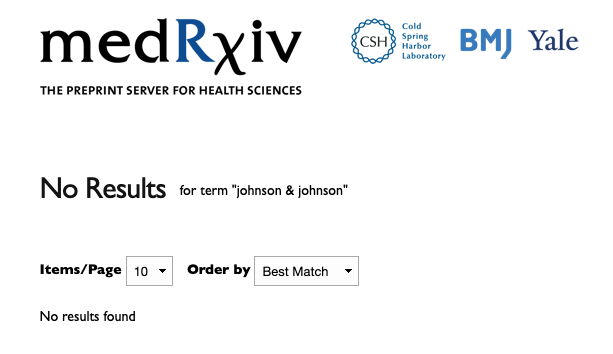medRxiv Gets Played — Again
As press releases become preprints, does EurekAlert feel threatened?
Back on March 24, 2020, I reported how a for-profit company had “played” medRxiv by claiming a preprint about their approach to Covid tracking would be posted on medRxiv. This preprint was alleged to detail the company’s attempts to use fever data, calculations about unexpected spikes or patterns, and derivations of supposed hotspots to identify simmering COVID-19 outbreaks. It was covered in the New York Times. The preprint itself was posted on April 10, 2020. The paper has never been published in a peer-reviewed journal.
Today, something similar appears to be going on, but this time the for-profit company promising a preprint on medRxiv while getting press release coverage in the New York Times is Johnson & Johnson. Per the New York Times report:

Sure enough, if you search medRxiv, there are no results for “johnson & johnson.”

Back in July, J&J published earlier data in NEJM, following the proven model of peer-reviewed study dissemination. But the vaccine races have heated up, so apparently J&J decided it was time to rush some new information out, even if that means a head fake toward medRxiv.
This raises — once again — core issues of the releationship of the press to science; the place of expert intermediaries regarding science and the public; the erosion of both and more that preprint servers represent; and, whether commercial entities now have unfettered promotional science channels at their disposal.
Back in May 2020, this was a topic of a post that covered even more ground and examples, and I quoted William Haseltine from the Washington Post, who gave this a name:
This is “publication by press release,” and it’s damaging trust in the fundamental methods of science and medicine at a time when we need it most. . . . Medicine and science are not matters of majority opinion; they are matters of fact supported by transparent data. This is the backbone of scientific progress and our only hope to end this pandemic. We can’t give up on our standards now.
I’ve asserted that preprints undermine peer-review — by providing distribution, branding, a DOI, and the air of legitimacy to papers that had not been carefully scrutinized by experts, editors, or professionals — and that this could lead to damaging erosion of scientific communication, washing away important guardrails. I’ve argued that the power of distribution, DOIs, and branding should be reserved, and granted only to authors willing to undergo editorial review, statistical review, peer review, and professional editing. And now we see a resurgent Covid variant in the wake of distrust of the science around the vaccine, likely caused at least in part by the disorganized and non-expert rounds of vaccine promotion and communication that occurred.
It’s tempting to say that this is another example of how preprints and journalists have taken over. But this is worse than that — it’s how press releases and journalists have taken over, and how the institutions of expert intermediaries have been sidelined during the largest public health crisis of our lifetime.
I’ll keep following this. Just wanted to make you aware.